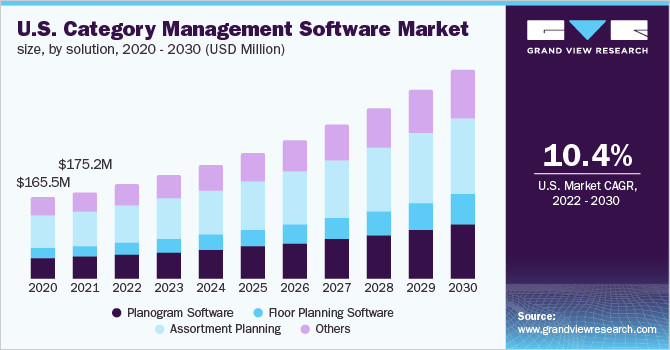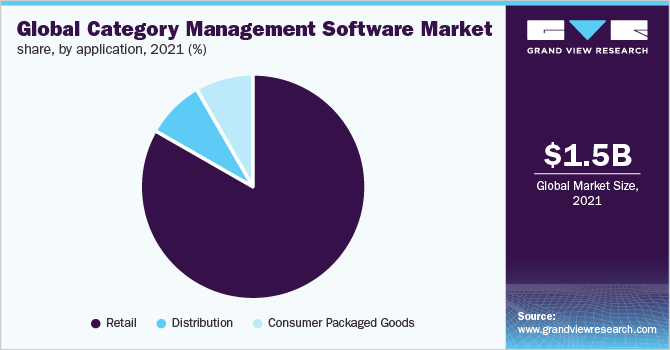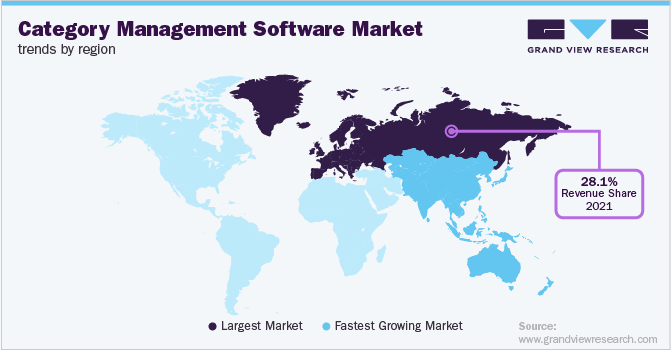- Home
- »
- Next Generation Technologies
- »
-
Category Management Software Market Size Report, 2030GVR Report cover
![Category Management Software Market Size, Share & Trends Report]()
Category Management Software Market (2022 - 2030) Size, Share & Trends Analysis Report By Deployment (Cloud, On-premise), By Enterprise Size (Large, SEMs), By Application, By Solution, By Service, And Segment Forecasts
- Report ID: GVR-4-68039-974-7
- Number of Report Pages: 130
- Format: PDF
- Historical Range: 2017 - 2021
- Forecast Period: 2022 - 2030
- Industry: Technology
- Report Summary
- Table of Contents
- Segmentation
- Methodology
- Download FREE Sample
-
Download Sample Report
Category Management Software Market Summary
The global category management software market size was estimated at USD 1.49 billion in 2021 and is projected to reach USD 3.79 billion by 2030, growing at a CAGR of 11.1% from 2022 to 2030. The growth of the industry can be attributed to the rising need for segmentation and classification of numerous product categories in retail stores to gain customer attraction.
Key Market Trends & Insights
- The Europe region dominated the global industry in 2021 and accounted for the maximum share of more than 28.10% of the overall revenue.
- Based on solution, the assortment planning segment dominated the industry in 2021 and accounted for the maximum share of more than 40.37% of the overall revenue.
- Based on deployment, the cloud-based deployment segment dominated the industry in 2021 and accounted for the largest share of more than 67.90% of the global revenue.
- Based on enterprise size, the large segment dominated the global industry in 2021 and accounted for the maximum share of more than 73.15% of the overall revenue.
- Based on application, the retail segment dominated the industry in 2021 and accounted for a share of more than 83.20% of the global revenue.
Market Size & Forecast
- 2021 Market Size: USD 1.49 Billion
- 2030 Projected Market Size: USD 3.79 Billion
- CAGR (2022-2030): 11.1%
- Europe: Largest market in 2021
- Asia Pacific: Fastest growing market
Category management solutions can also be used to find opportunities to build mutually beneficial relationships with suppliers. Moreover, category management software helps improve strategic sourcing, supplier onboarding, supplier relationship management, negotiation, performance management, and opportunity identification.
Furthermore, organizations can save money on materials, supplies, and inventories with the use of category management solutions. By leveraging category management solutions, it is simple to analyze vendor contracts and comprehend that retailers can earn minor gains by reducing procurement operations, further fueling industry growth. Implementing category management solutions and services can greatly reduce supply chain risk. Organizations can locate anomalous expenditure, discover places where they can make changes, and begin reducing costs using improved category management solutions which, in turn, is expected to create lucrative growth opportunities for the industry over the forecast period. Furthermore, category management software aids in initiating and managing collaboration with numerous suppliers.
Organizations can expedite the tedious elements of the job and save time on processing by using category management solutions. The rising focus of the companies on omnichannel systems to facilitate smoother operations in retail stores is a significant factor driving the adoption of category management software solutions. Accuracy of the inventory is a primary concern due to an increase in the demand for real-time inventory management solutions, which can be accessed through multiple channels. Better inventory accuracy and proper placements of the products to gain customer attraction are necessary to serve everyday customer orders. Hence, many retailers and vendors are adopting category management solutions in their stores and warehouses to maintain the inventories efficiently as well as maintain customer demands offline & online under omnichannel platforms.
In addition, the growing adoption of these solutions, owing to their comprehensive, customizable reports and graphing features, is expected to support the industry growth. Another factor aiding the growth is in-store merchandising reports for in-store implementation, days of supply reports for indicating potential out-of-stock and wastage issues, and space versus sales reports for determining the proper space distribution of items, brands, and categories. Companies having a supplier base across different areas, such as manufacturing, textile, chemical, mining, and construction, greatly benefit from these features, which is increasing the demand for category management software solutions.
A rise in the number of large retail stores to meet customer demands is also a significant factor boosting the industry growth. Large retail stores have thousands of Stock-Keeping Units (SKUs) across many product departments. The need arises to have a category management solution to properly plan and forecast the product stocks to achieve better performance and Return on Investment (RoI). Large retail stores across the globe are also planning to expand their presence aimed at providing better customer experiences to customers. For instance, Walmart planned to double the Indian wholesale chain by 2023. Such expansion activities by large retail stores are expected to create more growth opportunities for the industry over the forecast period.
COVID-19 Impact Analysis
The COVID-19 outbreak has impacted the industry positively. The changing business range & spaces have contributed to the industry growth post-pandemic providing businesses with a new way of trade, adding new customers, and catering to the growing demand for shelf space. Thus, the changing shopping habits and rapid digitalization have helped businesses grow as per the environment and cultural changes after the pandemic.
Solution Insights
On the basis of solutions, the global industry has been further categorized into planogram software, floor planning software, assortment planning, and others. The assortment planning segment dominated the industry in 2021 and accounted for the maximum share of more than 40.37% of the overall revenue. The major factor responsible for the segment growth is the ability of the assortment planning software to customize the assortments as per the requirement and allow the user to identify underperforming and exceptionally performing products in retail stores. Moreover, they also assist vendors in reducing the unnecessary space required for the inventory.
Such factors have increased the demand for assortment planning software, which bode well for the growth of the segment. The floor planning segment is anticipated to witness a significant growth rate over the forecast period. The growth can be attributed to the rising adoption of floor planning solutions owing to their ability to reduce the issue of limited product exposure and floor congestion for the designated area in the retail store. In addition, rising awareness about floor planning technology is further propelling segment growth. Moreover, this technology and software combo is responsible for digitization across SMEs and other organizations, boosting segment growth.
Service Insights
On the basis of services, the global industry has been further categorized into managed services and professional services. The professional service segment dominated the industry in 2021 and accounted for the largest share of more than 60.55% of the global revenue. This high share is attributed to the increasing adoption of professional services for addressing specific challenges to upscale their system. Moreover, professional services offer organizations various solutions, such as planogram development services, floor space optimization services, and assortment optimization services responsible for business development.
Furthermore, advanced troubleshooting and tech developments in professional services offer multiple opportunities for future growth prospects. The managed service segment is expected to witness the fastest growth rate over the forecast period. The ability of managed services to offer instant access to server and software problem troubleshooting is anticipated to augment the segment growth over the forecast period. As a result, businesses experience easy management of maintenance tasks and also equip them with features, such as unified communications, better administration, network monitoring, and onboarding.
Deployment Insights
On the basis of deployment, the global industry has been further categorized into cloud and on-premise. The cloud-based deployment segment dominated the industry in 2021 and accounted for the largest share of more than 67.90% of the global revenue. The segment is projected to expand further at the fastest growth rate maintaining its leading position throughout the forecast period. The increasing deployment of cloud-based category management software among vendors is anticipated to drive segment growth. Low entry costs, better scalability & integration, and pay-as-you-use facilities of cloud-based category management software are major factors contributing to the segment growth.
Moreover, using cloud-based models instantly enables global business data insights, which are responsible for productivity. Therefore, the segment is expected to witness significant growth over the projected period, owing to the increasing adoption of cloud-based software by merchants. The on-premise segment is expected to witness a moderate growth rate over the forecast period. The idea of maintaining better privacy standards than peers is driving the demand for on-premise category management software. The on-premise software offers functionalities and flexibility, which supports segment growth. Moreover, institutions that desire control over their software and data choose on-premise deployment to overcloud deployment.
Enterprise Size Insights
On the basis of enterprise size, the global industry has been further categorized into large enterprises and Small & medium enterprises (SMEs). The large enterprise size segment dominated the global industry in 2021 and accounted for the maximum share of more than 73.15% of the overall revenue. The large enterprise requires management of heavy data flow from a large customer base. This is the major factor expected to propel the segment's growth. Furthermore, the strong financial capability of these enterprises is contributing significantly to the market development as the shift from traditional business models to tech-enabled models.
As a result, the adoption of software becomes viable for the segment, which is anticipated to drive segment growth. On the other hand, the SME enterprise size segment is expected to witness the fastest growth rate during the forecast period. Small & medium enterprises are adopting category management solutions so as to enhance their planning of assortment brands in an efficient way aimed to drive the growth of in-store purchasing. Thus, the growing adoption of this software by SMEs is driving segment growth.
Application Insights
The retail segment dominated the industry in 2021 and accounted for a share of more than 83.20% of the global revenue. The segment is also anticipated to witness the fastest CAGR throughout the projection period. The growth is attributed to the structural shift from mortar and brick stores to the hybrid physical and digital environment that retailers adopt nowadays. The category management software enables retailers to anticipate demand and alignment of assortments, which contributes significantly to the adoption of retail category management software by modern retailers. Moreover, category management solutions also aid retailers in the translation of assortment decisions into executable plans that optimize business with maximum allocation.

Thus, the segment dominates the industry and is expected to sustain its leading position during the forecast period. The consumer packaged goods segment is expected to grow substantially over the forecast period. The growing need for tech-integrated supply chain management software is driving the segment growth. Suppliers, distributors, and retailers that are part of the consumer goods supply chain are adapting to the changing consumer preference and maintaining steady growth. Moreover, real-time information enables businesses to generate business growth reports regarding finances, inventory, and more, which is further propelling segment growth.
Regional Insights
The Europe region dominated the global industry in 2021 and accounted for the maximum share of more than 28.10% of the overall revenue. The growing demand from retailers to connect shopper insights to their supply chain and the high importance given by European retailers to assortment management are major factors propelling the segment growth. Moreover, category management software resolves the struggle to collaborate with CPG partners and offers a better business model to the vendors. Hence, the growing adoption of management software by European retailers is anticipated to increase the growth of the overall market.

On the other hand, the APAC region is expected to register the fastest growth rate during the forecast period. This growth is attributed to the implementation and use of this software by major APAC retail players. Furthermore, these players are adopting category management software for combined multichannel and omnichannel retailing into single commerce, known as unified commerce. As a result, from the Point of Sale (POS) to e-commerce and CRM to inventory management, the high use of connected systems is expected to drive the segment over the forecast period.
Key Companies & Market Share Insights
The industry is highly fragmented. Prominent players are focusing on expanding their customer base by adopting new technologies and business strategies to gain higher industry shares. For instance, in 2022, Epicor, a global leader in enterprise software, acquired Data Interchange, a U.K.-based Electronic Data Interchange (EDI) provider, to promote business growth. This acquisition expands the reach of Epicor in European markets, which is expected to increase its efficiency and drive value in the supply chain. Furthermore, businesses prefer to get services from category management software providers for forecasting, reporting, and planning. For instance, in July 2022, Board International S.A. announced being selected by Cornerstone Building Brands for gaining project visibility in budgeting, forecasting, reporting, capex planning, and tax provisioning. Some of the prominent players in the global category management software market are:
-
Oracle Corp.
-
Aptos, LLC
-
Board International S.A.
-
INTERACTIVE EDGE
-
42 Technologies, Inc.
-
Epicor Software Corp.
-
Softvision
-
GEP
-
JAGGAER
-
DotActiv (Pty) Ltd.
Recent Developments
-
In July 2022, JAGGAER announced the 22.2 version of the JAGGAER ONE series. The release includes a full spectrum of source-to-pay improvements designed to ensure frictionless transactions on the buyer and supplier side.
-
In May 2021, Epicor acquired KBMax, a provider of quote configuration (CPQ) and visualization software. With this acquisition, Epicor has integrated its ERP system with KMax's next-generation CPQ tools, enabling customers to gain critical touch points for inventory, cost, pricing and customer data.
-
In February 2021, Aptos acquired LS Retail, a company specializing in the development of all-in-one software systems for retail, food service, pharmacy, & restaurant businesses. Since this acquisition, the combination of Aptos and LS Retail has aimed to create a retail technology powerhouse uniquely equipped to support retailers at all levels.
Category Management Software Market Report Scope
Report Attribute
Details
Market size value in 2022
USD 1.63 billion
Revenue forecast in 2030
USD 3.79 billion
Growth rate
CAGR of 11.1% from 2022 to 2030
Base year of estimation
2021
Historical data
2017 - 2021
Forecast period
2022 - 2030
Quantitative units
Revenue in USD million/billion and CAGR from 2022 to 2030
Report coverage
Revenue forecast, company market share, competitive landscape, growth factors, and trends
Segments covered
Solution, service, deployment, enterprise size, application, region
Regional scope
North America; Europe; Asia Pacific; Latin America; MEA
Country scope
U.S.; Canada; Germany; U.K.; China; India; Japan; Brazil
Key companies profiled
Oracle Corp.; Aptos, LLC; Board International S.A.; 42 Technologies, Inc.; Epicor Software Corp.; Softvision; GEP; JAGGAER; DotActiv (Pty) Ltd.
Customization scope
Free report customization (equivalent to up to 8 analysts working days) with purchase. Addition or alteration to country, regional & segment scope
Pricing and purchase options
Avail customized purchase options to meet your exact research needs. Explore purchase options
Global Category Management Software Market Segmentation
This report forecasts revenue growth at global, regional, and country levels and provides an analysis of the latest industry trends in each of the sub-segments from 2017 to 2030. For the purpose of this study, Grand View Research has segmented the global category management software market report based on solution, service, deployment, enterprise size, application, and region:
-
Solution Outlook (Revenue, USD Million, 2017 - 2030)
-
Planogram Software
-
Floor Planning Software
-
Assortment Planning
-
Others
-
-
Service Outlook (Revenue, USD Million, 2017 - 2030)
-
Managed Services
-
Professional Services
-
-
Deployment Outlook (Revenue, USD Million, 2017 - 2030)
-
On-premise
-
Cloud-based
-
-
Enterprise Size Outlook (Revenue, USD Million, 2017 - 2030)
-
Large Enterprises
-
Small & Medium Enterprises
-
-
Application Outlook (Revenue, USD Million, 2017 - 2030)
-
Retail
-
Distribution
-
Consumer Packaged Goods
-
-
Regional Outlook (Revenue, USD Million, 2017 - 2030)
-
North America
-
U.S.
-
Canada
-
-
Europe
-
Germany
-
U.K.
-
-
Asia Pacific
-
China
-
India
-
Japan
-
-
Latin America
-
Brazil
-
-
Middle East & Africa
-
Frequently Asked Questions About This Report
b. The global category management software market size was estimated at USD 1.49 billion in 2021 and is expected to reach USD 1.63 billion in 2022
b. The global category management software market is expected to grow at a compound annual growth rate of 11.1% from 2022 to 2030 to reach USD 3.79 billion by 2030
b. Europe dominated the category management software market with a share of 28.15% in 2021. The growing demand of retailers to connect shopper insights to their supply chain and high importance given by European retailers on assortment management are major factors propelling the segment growth.
b. Some key players operating in the category management software market include Oracle Corporation, Aptos, LLC, Board International S.A., 42 Technologies, Inc., Epicor Software Corporation, Softvision, GEP, JAGGAER, DotActiv (Pty) Ltd.
b. Key factors that are driving the category management software market growth include growing demand for omni-channel retailing, a rise in the number of retail stores, and an increasing need for compliance in stores.
Share this report with your colleague or friend.
Need a Tailored Report?
Customize this report to your needs — add regions, segments, or data points, with 20% free customization.

ISO 9001:2015 & 27001:2022 Certified
We are GDPR and CCPA compliant! Your transaction & personal information is safe and secure. For more details, please read our privacy policy.
Trusted market insights - try a free sample
See how our reports are structured and why industry leaders rely on Grand View Research. Get a free sample or ask us to tailor this report to your needs.










